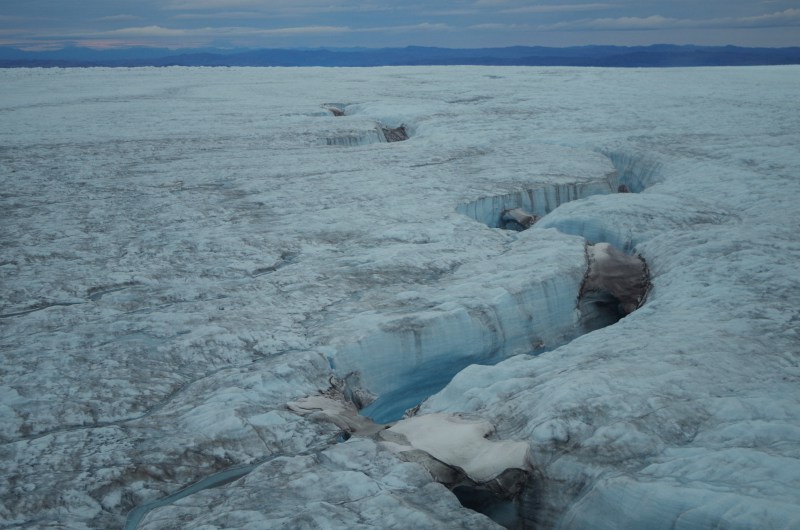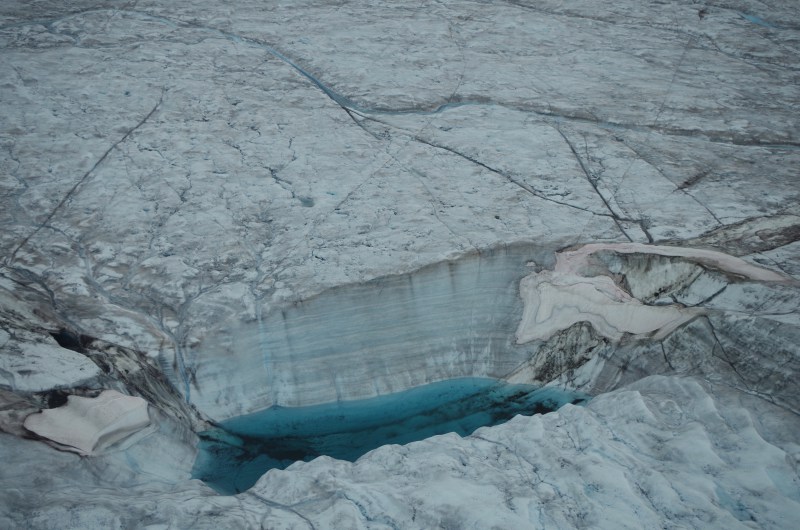Blog: Field notes from Greenland – From the glacier to the sea

The Greenland Ice Sheet is constantly in flux and is far from static.
The world’s second largest body of ice has been especially dynamic in the past several years as climate change’s positive feedback loops have exacerbated melting. The region of northeast Greenland, for instance, maintained its mass from year to year until 2003. But in the past ten years, on average, it has been losing 10 billion tons of ice a year, according to researchers at the Technical University of Denmark.
When melting, some of the ice sheet begins to drain from the surface via supraglacial rivers such as the one pictured in the above photograph, which I took from a helicopter flying low across the surface. The research team of which I’m a part has been studying the area of the ice sheet in western Greenland. From this region, water drains into the Davis Strait separating Greenland and Baffin Island, Canada. We flew to the surface of the ice, about 50 kilometers inland from the edge, to study these rivers. They cut winding curves ranging from deep blue to crystal-clear azure in the ice. Some flow in shallow channels on top, while more powerful ones cut deep, incised canyons into the ice, like the one below.

Nearly all of these supraglacial rivers end in moulins – holes in the ice sheet that are formed by flowing water, a topic my colleague, UCLA PhD candidate Vena Chu has researched. (There are also some helpful diagrams on her website that illustrate glacial drainage systems.) After traveling through a moulin, meltwater can drain out of the face of the ice edge or at the bottom of the glacier, lubricating its surface. In the below picture, the dark hole on the bottom of the left of the turquoise lake, sitting below two small waterfalls, appears to be a moulin. The lake water may have previously been level with the surface of the ice, but it could have since drained out through that glacial rabbit hole.

The photograph below shows, from foreground to background, the crevasse fields at the edge of the ice sheet, the moraines pushed up by the retreating Russell Glacier, and the drainage basin in the west. The undulating tundra-covered hills are some classic features of a glacially carved landscape.

Eventually, at least coming off the Russell Glacier east of Kangerlussuaq, the meltwater flows via a number of meltwater outflow streams into the massive, churning, sediment-rich Qinnguata Kuusua (Watson River). Another one of my colleagues, Lincoln Pitcher, shot a video of the raging river in July 2012 after five consecutive days of above-freezing temperatures across the Greenland Ice Sheet generated what The Guardian called “an unprecedented thaw.”
The Watson River wends its way through the 60-kilometer long fjord leading out to sea. But it’s not just water flowing downstream. First of all, the water transforms from being incredibly clear up on the ice to being thick, gray, and chock-full of sediment after traveling only a few kilometers downstream. By the time it gets to Kangerlussuaq and passes under the town’s bridge, it’s essentially a rock, soil, and sand smoothie. And it’s not just earth that gets mixed into the river. During the 2012 flooding, an entire front-loader was washed downstream, as seen in Pitcher’s video. What’s more, the bridge over the Watson River was named after Jack T. Perry, who died while attempting to navigate the river in 1976 – a somber reminder of the power of glaciers, even once they have begun to melt.

This post first appeared on Cryopolitics, an Arctic News and Analysis blog.




